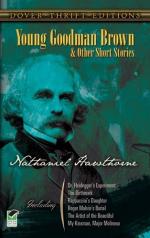|
This section contains 2,095 words (approx. 7 pages at 300 words per page) |

|
SOURCE: “Freudianism, American Romanticism, and ‘Young Goodman Brown,’” in CEA Critic, Vol. 33, No. 3, March, 1971, pp. 3-6.
In the following essay, Campbell criticizes the trend among Hawthorne critics to interpret “Young Goodman Brown” in Freudian terms, pointing out that this approach tends to oversimplify and narrow the interpretation of the story.
Certainly Freudian criticism has made substantial contributions to the understanding of some aspects of American romanticism—in studies of the sexual symbolism in much of Whitman's best poetry, the tortured ambiguities of Melville's Pierre and some of his short stories, and the relation between Poe's probable impotence and his creative work, to mention only a few examples that come readily to mind. It has even been said that some of the American Romanticists themselves anticipated Freud in describing the shadowy subliminal origin of some of their images. It seems to me, however, that in the twilight area between...
|
This section contains 2,095 words (approx. 7 pages at 300 words per page) |

|


